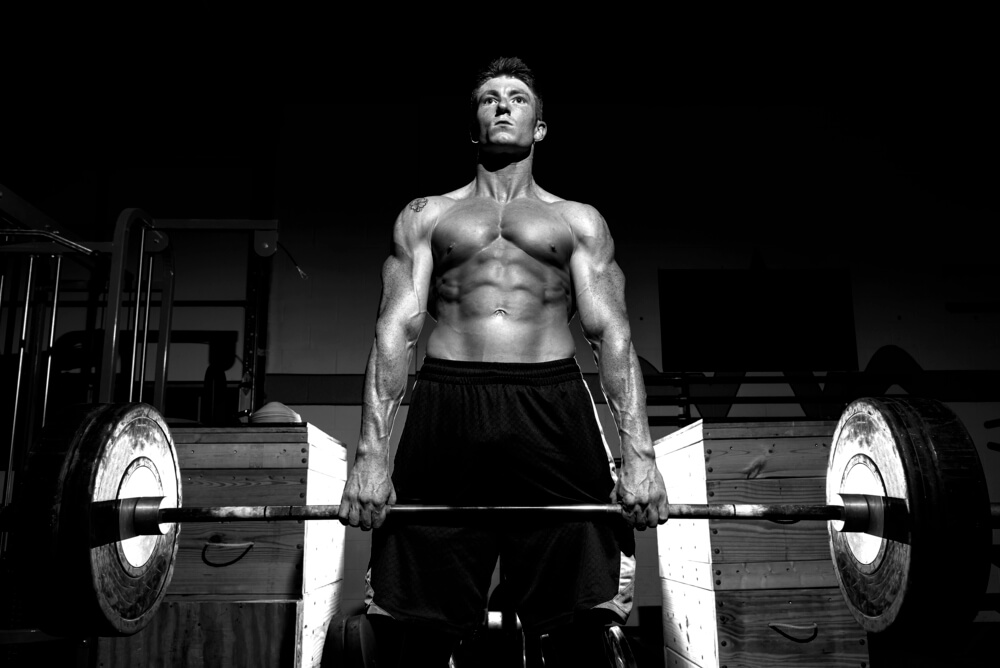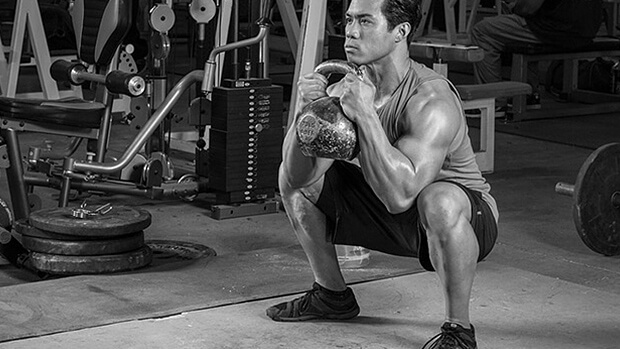
Want a full body split for better gains? Guess what? You came to the right place. We give you all the info and the workout to get you where you want to be. You’re welcome!
The search for better gains is still ongoing. The good news is that one type of training that will help you to help achieve this goal is the full body split program. There are all sorts of training programs out there for you to choose. This article is not to say that only this particular way is a good choice. Not at all! Instead, we are just trying to give you another tool for your training arsenal.
The full body split is highly effective for muscle gains and strength. This, in turn, allows us to develop many other benefits to be discussed. But, before we get into all of that, let’s first take a look at the full body split workout to see what all the fuss is about.

What Exactly Is A Full Body Split?
A full body split is essentially just saying you will perform a full body workout. This technical term is simply used to note that your workout is splitting time to target all the main muscle groups. As a general rule, you will usually only want to perform compound lifts with a few isolation lifts as part of this training program.
The full body split is widely used for two main reasons:
- The full body split requires only two or three training days per week.
- This training program is highly effective for better gains.
Buy how can training with less frequency in each week encourage better gains?
Good question. The reason for this is because when you perform a full body workout you require a full rest day to repair your muscles and recover. These extra rest days are actually better for gains and several top fitness athletes swear by it.
A full body split can be done a couple of different ways. You can do so by either doing a compound lift followed by an isolation exercise for that muscle region, or by just doing compound movements only. Either way is fine as long as you are equally hitting all of your muscle regions to prevent growth deficiencies from gains coming on too quickly.
Here’s The Info On Compound Lifts, Isolation Lifts, And Isometric Training
In order to understand how to program a full body split training schedule, you probably need to have a good understanding between lift variations. We will take a look at compound lifts first because they are the most important tools for all training programs.
A compound lift uses multiple joints and/or muscle groups to perform a movement. For example, the deadlift is a compound lift because it uses both lower and upper body muscles to perform the movement. This is the best type of movement for gains all around.
The way your muscle gains increase even further through the use of compound movements is because of the stabilizer muscles that get used. These are smaller muscles that do not really belong to a particular region or are ones in a primary region that are used for a different purpose. These stabilizer muscles keep your body balanced and ensure that you will not be falling over.
Another compound exercise example is the standing overhead shoulder press. You must use your lower body and core muscles in order to keep your spine safe and prevent falling down. Then you have the bench press using your legs and core to prevent falling to either side. In the end squats, deadlifts, overhead presses, the bench press and even pull-ups are all top compound lifts to consider doing.
Next, we have isolation lifts. The name pretty much tells the whole story.
What’s that?
These types of lifts are for isolating a particular muscle region. This means only one or two large muscles are being contracted during the exercise. For example, the biceps curl isolates the biceps muscle and uses your triceps during the eccentric portion as well.
No other portion of your body is really being used beyond normal activity, so only your upper arms are seeing any progress when doing a biceps curl. That’s why it is always advised to do compound lifts prior to isolation. You would not want to use all of your muscle energy for one region instead of multiple regions.
Another awesome type of exercise that you could use is isometric training. Isometric exercises are ones where no movement is made after getting into a specific position. Once in position you simply hold it for a certain amount of time to encourage contractions. This type of exercise is generally done to focus on muscle endurance and strength. A few examples of exercises you can use would be planks, wall sits or even holding the up position of push-ups.
These three types of exercises should be mixed together in your training routine, and can even be used for supersets and burnouts.
Supersets, Compound Sets And Burnouts For Full Body Split Training
A superset is when you do an exercise and then perform another exercise right away that focuses on an opposing muscle group. For example, you perform biceps curls and then follow that up right away with triceps pull down.
A compound set is much like a superset. The difference is both exercises being performed back to back are for the sample muscle group. An example would be doing squats and then following that up with jump squats. Both variations of using two exercises are perfect for full body workouts.
A burnout is different from the other two. Burnouts are when you do a specific exercise continuously until your muscles become fatigued and fail. Basically, you do an exercise until failure. An example would be doing machine chest flyes until you can no longer do anymore. This is performed with lighter weight. It is intended to increase muscular endurance and growth.
You do not really need to insert all three of these into the same workout. Using only one type will suffice in making your full body split much better for your gains.
Rest Is The Important Factor That Allows Gains To Occur
As mentioned, the reason a full body split workout program allows for great gains is simply because you take more rest days off. A rest day means you do not perform any types of training beyond that of your normal daily activities. You, of course, can walk around, go to work and do anything else that you perform during a routine day.
The reason for this rest is to allow more time for protein synthesis to occur. You need 24 to 48 hours of rest for each muscle region targeted through training to recover properly.
Protein synthesis is when your body sends digested protein to your muscle cells after you workout. These cells take the new protein and use them to repair, which results in muscle gains. In the end, you will have stronger and denser muscle fibers. The minimum amount of time needed is 24 hours. With that said, 48 hours is advised.
On top of this you need eight hours of sleep to really feel the effects of recovery and allow your body the chance to balance out again. Studies have shown that deep sleep does not necessarily have to be consecutive. In other words, if you have to get up every now and then that sleep can still be good enough for recovery.

This Is The Ultimate Full Body Split Program
Now that you have a better idea about what goes into a full body split, we can move on to a program you can try. The following is designed for three days of training and four days of rest. You will be using all the different types of lifts that we have discussed.
The key concept to remember is doing each exercise with proper form. This prevents injury and allows you to have the best gains possible. If you have to slow down and practice an exercise, then do it. Nothing good will result by doing an exercise wrong. Use only moderate resistance for all exercises unless they are bodyweight movements.
This Is Day 1
Exercise Set Reps
Barbell Squat x4 x8-10
Flat Bench Dumbbell Press x4 x8-10
Overhead Barbell Press x4 x8-10
Superset
Pull-Up x3 x12
Dip x3 x12
This Is Day 2.
Rest
This Is Day 3.
Exercise Set Reps
Deadlift x4 x8-10
Incline Barbell Press x4 x8-10
Goblet Squat x4 x8-10
Compound Set
Wide Grip Upright Row x3 x10
Dumbbell Neutral Grip Overhead Press x3 x10
This Is Day 4.
Rest
This Is Day 5.
Exercise Set Reps
Bent Over Row x4 x8-10
Barbell Flat Bench Press x4 x8-10
Dumbbell Chest Flye x4 x8-10
Compound Set
Front Squat x3 x8
Dumbbell Lunge x3 x8
This Is Day 6 And Day 7.
Rest

Keep Your Training Program From Becoming Routine
When it comes to making gains, a routine is not always the greatest thing. Sure, one type of training method will work for a bit. But, over time, your body knows what is going on and will at some point not progress much further no matter how hard you try. That is why mixing up your routine is a good idea.
You can simply switch out exercises in the program by using different equipment. In other words, you could use dumbbells or kettlebells instead of using the barbell. You could add weight to bodyweight exercises if you wish. Of course, another course of action is simply switching out exercises with similar ones for that muscle group.
When it comes to changing up your program, the choices are endless. But, you want to always remember that you not only change exercises around. You also want to increase resistance over time. Why? Staying with the same resistance for four months is just not going to get you very far with your workouts when it comes to achieving gains.
Conclusion
Keep in mind that the program given is a general training program and may not work for some. Why? The reason is because each person has a different body type. They may or may not have injuries to work around.
Trainers will always tell you their program will work better because it is catered to your body and needs. This is a true statement and you should definitely consider hiring a personal trainer if all of this is too new to you. But, if you just need some tips and pointers, then by all means, take part in the program given.
We did not really cover the topic of a warm up, but you should always consider warming up before training and then performing static stretching afterward. A good warm up would be doing the elliptical for two minutes followed by three minutes of bodyweight movements. This could be choosing three exercises to perform for 20 seconds each and then doing three rounds of them.
Static stretches come after training because you are telling your muscles to go to sleep. A static stretch is when you pull a joint through its full range of motion. You then hold this position for 20 to 30 seconds. Do not perform these stretches prior to training.
Why?
The reason is because you actually decrease muscular strength. This is why many athletes never do anything before their training program.
Your full body split program for better gains should consist of all of the topics we have discussed. Mix things up. And, never forget to keep your routines fresh. This could make all the difference.
By Adam Clark, CPT
Latest posts by Terry M (see all)
- Garage Gyms - Aug 1, 2018
- Kettlebells – Why They Should Be Added To Your Routine. - Jul 24, 2018
- Weight Belts: What Are They Really For? - May 31, 2018










An athlete is not just an athlete, but also despot an Olympic-style disciplinarian and a gymnast. They are a “magnate”, a complete potent. Right choice of workouts is very important for any athletes are if they want to make progress.